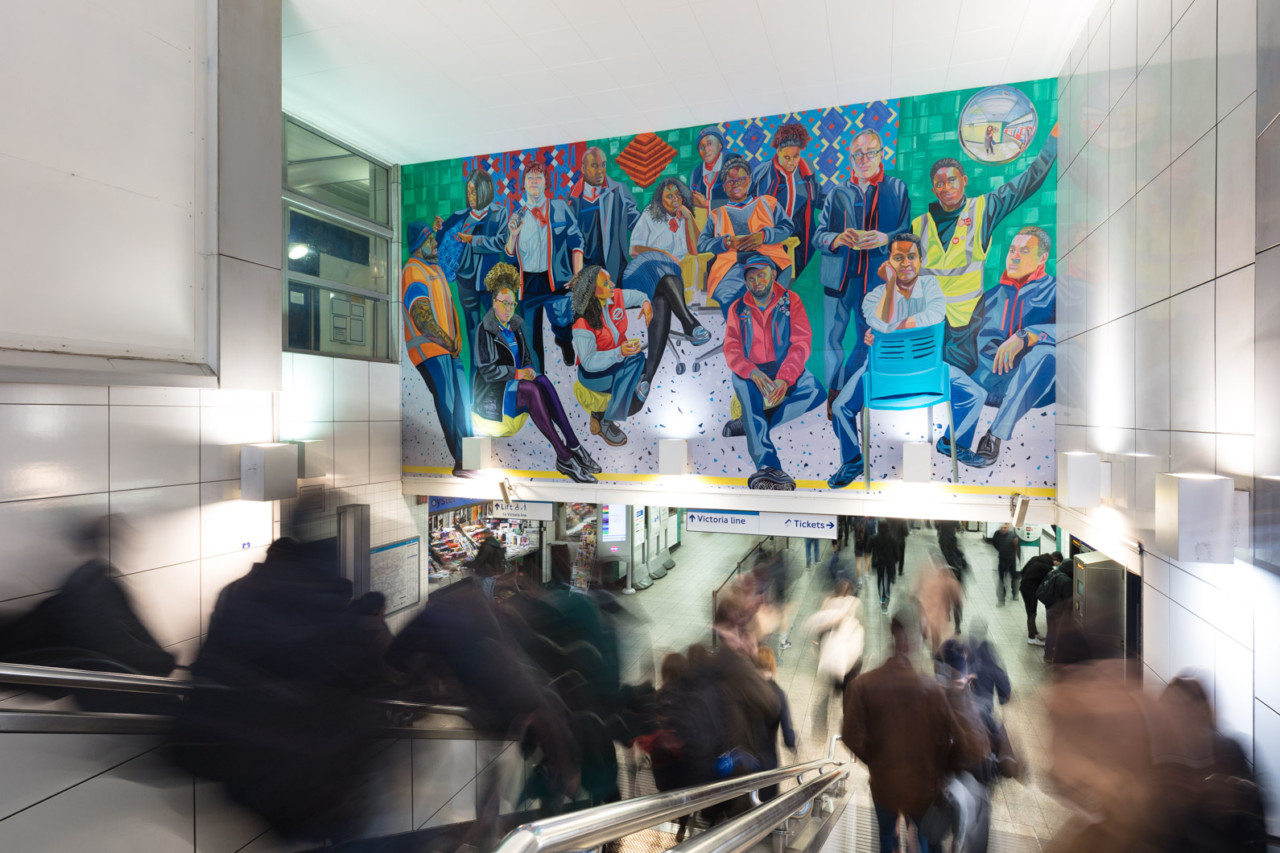


Mexican born, New York-based painter Aliza Nisenbaum has become known for her exquisitely painted portraits of under-represented and marginalised communities in the US. Citing the Mexican mural movement’s depiction of social history as formative to her practise, Nisenbaum states: “I’m interested in the politics of visibility: who and why someone is depicted…to pay attention to someone can be a political act.”
Last year we presented Nisenbaum’s painting Susan, Aarti, Keerthana and Princess, Sunday in Brooklyn (2018) to Norwich Castle Museum through the Contemporary Art Society’s Valeria Napoleone XX CAS scheme. Intimately depicting a two-mother couple of dual heritage with their daughters in their living room in New York, this was a landmark acquisition as it was the first work that represents women of colour in Norwich’s collection.
In December 2018 Nisenbaum began a three-month Art on the Underground artist-in-residency in a studio next to Brixton Station. Her new portrait commission, inspired by the community spirit of the 1980s Brixton murals, again points us towards those who are often overlooked by society. Each of Nisenbaum’s sitters works for the Transport for London network across the Victoria line, including train drivers, operational staff and those working in facilities and administration.
The subjects pose against a backdrop of iconic patterns and features of London’s underground system: the vinyl floor of a train carriage, the yellow line on station platforms, the fabric design used for the seats on the Victoria Line and the colourful wall-tiles of Brixton Station. Nisenbaum selected the participants for her portrait painting through an open call and, at the end of her residency, the painting was photographed, enlarged and printed onto vinyl to fit the station’s 9 x 5-meter-long wall. Now the large brightly coloured group-portrait of 15 TfL staff greets many thousands of commuters from the entrance wall of Brixton Station each day.
While making the work, Nisenbaum had each TfL staff member sit with her individually in the privacy of her studio for a couple of hours. This gave her the opportunity to engage closely with each person, listening to their stories about growing up in Brixton and their experiences of working for the London Underground over many years. When I visited Aliza Nisenbaum in her studio in January, she explained that many of the subjects of her painting came to Brixton as a result of immigration and belong to the so-called Windrush generation, whose scandal caused by the Home Office has been featured in the news repeatedly in recent months.
Like in the paintings of the Old Masters, her subject’s expressions and gestures are rendered in intimate detail. Each face is imbued with personality, which is further supported by Nisenbaum’s bright and contrasting colours. The group is carefully composed and each sitter wears standard a TfL uniform, as if posing for a photo shoot. The men and woman appear mighty in their quiet grace and the masterly composition suggests a modern version of Rembrandt van Rijn’s (1606 -1669) group-portrait The Nightwatch (1642).
Like Rembrandt, who included his self-portrait in his painting, a small depiction of Nisenbaum taking a selfie in front of a departing or incoming tube – reflected in a convex safety mirror – appears in the upper right corner of the painting. That she included a representation of herself, separated from the TfL group, might indicate that although she spent a long and intense time among the staff, getting to know the individuals as well as the Brixton community, she is not part of this community, but rather an observer in transition.
Nisenbaum’s practice is socially engaged, and her paintings are the result of the individual exchanges between herself and her subjects. Her elaborate oeuvre challenges the social and representational hierarchies of traditional portraiture. For Nisenbaum, the people she paints are not passive sitters but active and engaged collaborators who are depicted with grace, composure and pride at a time when society often treats them as invisible.
The large group portrait now in the entrance of Brixton Station places the TfL staff into the public realm. Due to the sheer size of the wall vinyl and Nisenbaum’s bright and contrasting colour-palette, the sitters can no longer be overlooked. They successfully manage to captivate us with their psychological intensity. Some gaze curiously, others proudly at the viewer, while others seem to be deep in thought. Nisenbaum encourages us to slow down, to really look at the people around us and to reflect who is rendered invisible or unacknowledged within the political and social spaces we inhabit.
Christine Takengny
Curator
A free Artist Talk with Aliza Nisenbaum and Oliver Basciano organised by the Contemporary Art Society, Art on the Underground and Central Saint Martins, University of the Arts London will take place on Monday 15 April at the Granary Building, 1 Granary Square.
The original painting will be shown at Aliza Nisenbaum’s forthcoming exhibition at Anton Kern Gallery in New York from 12 September 2019.
Brixton Underground Station, Atlantic Road, Brixton, London.
Open daily. Display continues until 16 September 2019. www.art.tfl.gov.uk